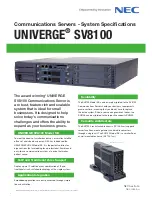
March 2013
Dell EqualLogic Configuration Guide v14.1
13-121
Figure 40
Connection Paths for FS7500 Client LAN
Figure 41 below shows the iSCSI SAN, IPMI, and node interconnect paths. Pay careful attention to how
the controller ports alternate between redundant switch paths.
Note:
With the exception of the IPMI connection paths, corresponding ports on each
controller node must connect to the same SAN switch. This connection pattern is shown
in Figure 41.
Sizing the iSCSI SAN Inter-Switch Connection for FS7500
The inter-switch connection sizing guidelines provided in Section 7.2.2 also apply to FS7500 SAN
design. The FS7500 mirrors the write cache between controller nodes. To accomplish this, all write
operations are transmitted across the controller interconnect. Thus, it is very important that you follow
connection pattern shown in Figure 41 to ensure corresponding ports are connected to the same
switch. This connection pattern prevents controller interconnect traffic from crossing the inter-switch
connection.
















































